
A rice cake may be any kind of food item made from rice that has been shaped, condensed, or otherwise combined into a single object that has also been sweetened. A wide variety of rice cakes exist in many different cultures in which rice is eaten, and are particularly prevalent in Asia. Common variations include cakes made with rice flour, those made from ground rice, and those made from whole grains of rice compressed together or combined with some other binding substance.
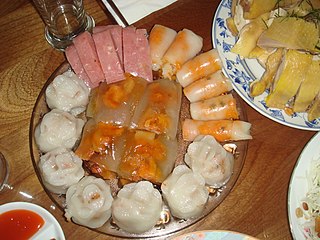
In Vietnamese, the term bánh translates loosely as "cake" or "bread", referring to a wide variety of prepared foods. With the addition of qualifying adjectives, bánh refers to a wide variety of sweet or savoury, distinct cakes, buns, pastries, sandwiches, and other food items, which may be cooked by steaming, baking, frying, deep-frying, or boiling. Foods made from wheat flour are generally called bánh, but the term may also refer to certain varieties of noodle and fish cake dishes, such as bánh canh and bánh hỏi.
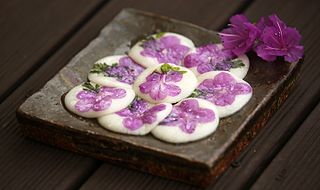
Hwajeon, or flower cake is a small Korean pan-fried rice cake. It is made out of glutinous rice flour, honey and edible petals from seasonal flowers, such as rhododendron. It is eaten during the festivals of Samjinnal and Buddha's Birthday.

Garae-tteok (가래떡) is a long, cylindrical tteok made with non-glutinous rice. Grilled garae-tteok is sometimes sold as street food. Thinly sliced garae-tteok is used for making tteokguk, a traditional dish eaten during the celebration of the Korean New Year.

Bánh lá, literally meaning "leaf cake", is a category of bánh, or Vietnamese cakes, that consist of a parcel of a variety of rice stuffed with some fillings and wrapped in a leaf or leaves.

Sirutteok (시루떡) is a type of Korean rice cake (tteok) traditionally made by steaming rice or glutinous rice flour in a "siru" (시루), a large earthenware vessel used for steaming which gives "sirutteok" its name. "Sirutteok" is regarded as the oldest form of tteok in Korean history.
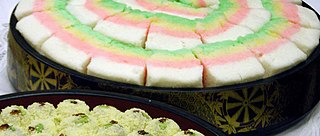
Mujigae-tteok (무지개떡) or rainbow rice cake is a layered tteok of different colors resembling a rainbow. It is used for special occasions such as a banquet, party, or feast like doljanchi, hwangapjanchi. Alternative names for mujigae-tteok include saektteok (색떡) and saekpyeon (색편), both of which means "colored rice cakes".
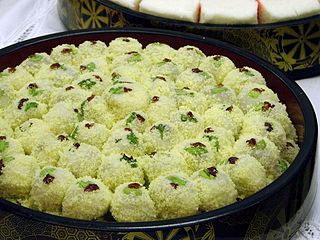
Bupyeon (부편) is a type of steamed tteok, used in traditional weddings. It is a local specialty of Miryang, South Gyeongsang Province.

Gaepi-tteok (개피떡) or baram-tteok (바람떡) is a half-moon-shaped tteok made with non-glutinous rice flour and filled with white adzuki bean paste.
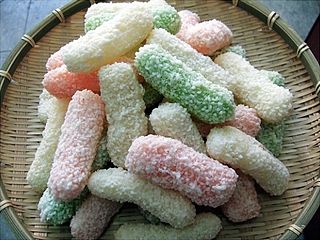
Yugwa is a type of hangwa made with glutinous rice flour and then deep-fried. It is a moderately sweet, crispy snack with a hollow inside that melts in the mouth.

Gyeongdan (경단) or Korean rice ball cake is a type of tteok made of glutinous rice or other glutinous cereal flours. When the cereal other than rice is used, its name is usually specified, making compound nouns such as susugyeongdan. The name chapssalgyeongdan may also be used, but chapssal can be, and usually is, omitted.
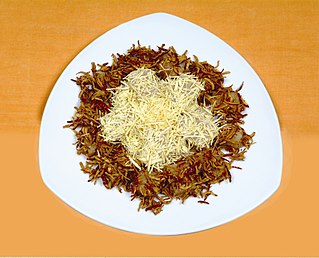
Danja is a variety of steamed tteok made with glutinous rice flour, sweet fillings, and sweet coatings.

Baekseolgi (백설기) is a kind of rice cake (tteok) made of rice flour dough. It is originated in Korea and a prime part of Korean culture. A Baekseolgi contains rice flour, sugar, and salt. It is usually eaten on the special occasions among Korean people, such as the 100th day of an infant after birth. The cakes are colored white, a colour that symbolizes purity and holiness. Because of the special occasions they are eaten, the cakes are never shared with neighbors or friends, but only with family members.
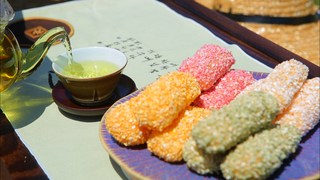
Gangjeong (강정) is a hangwa made with glutinous rice flour. It is a deep-fried "rice puff" with hollow inside, coated with honey followed by nutty beans, nuts, seeds, pollen, or spice powders. Gangjeong is often served during important events such as weddings, ancestral rites, and Korean New Year celebrations.

Jeolpyeon (절편) is a type of tteok made of non-glutinous rice flour. Unlike when making siru-tteok or baekseolgi, the rice flour steamed in siru is pounded into a dough, divided into small pieces, and patterned with a tteoksal. The stamps can be wooden, ceramic, or bangjja (bronze), with various patterns including flowers, letters, or a cartwheel. When served, sesame oil is brushed over jeolpyeon.
Chanochi (차노치) is a Korean dish. It is pink, pan-fried tteok or jeonbyeong (pancake) made with glutinous rice flour. It is a regional dish of the Yeongnam region.

















